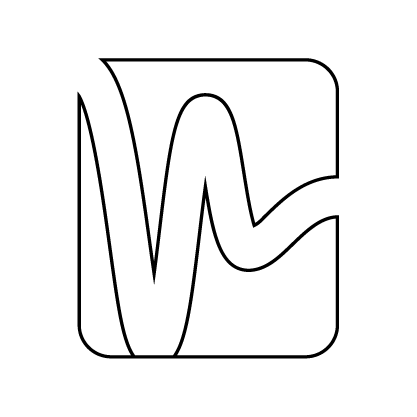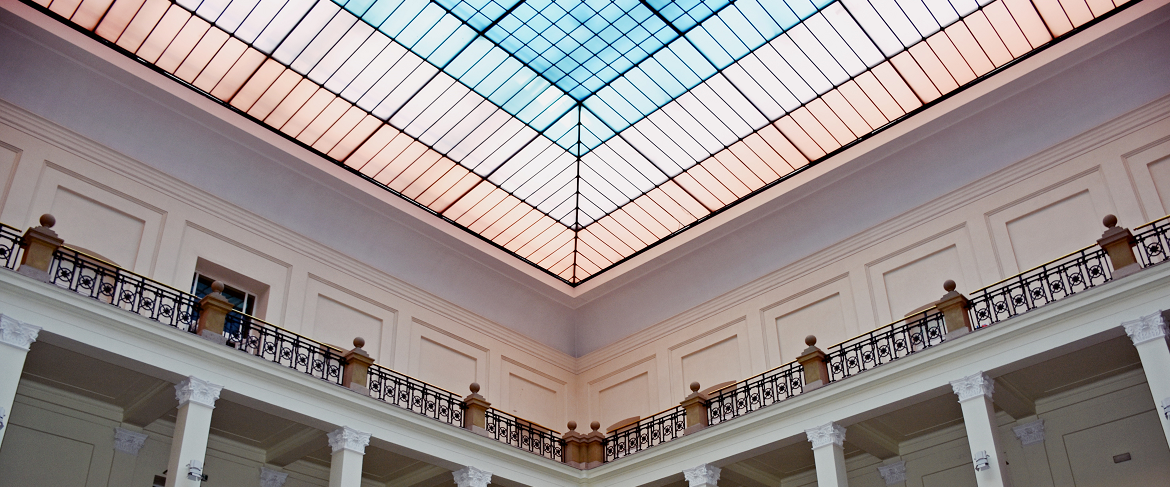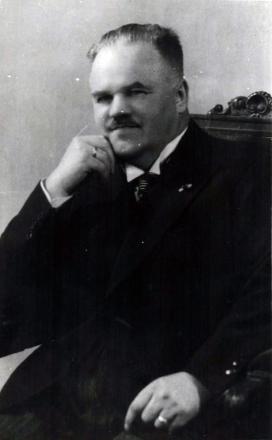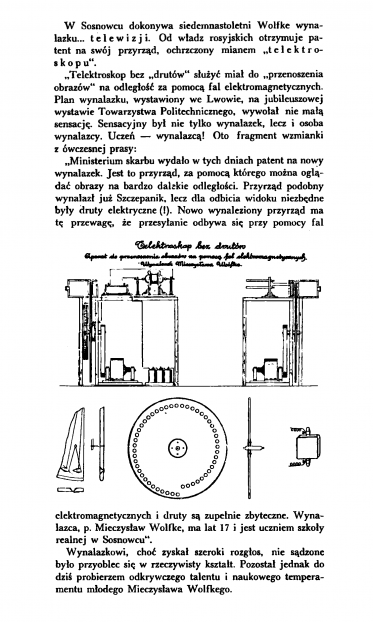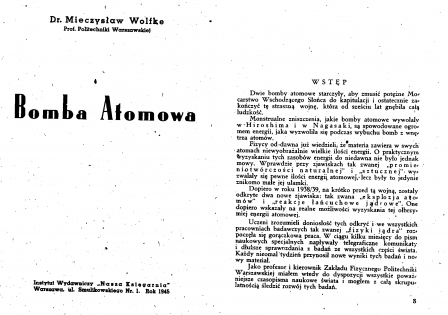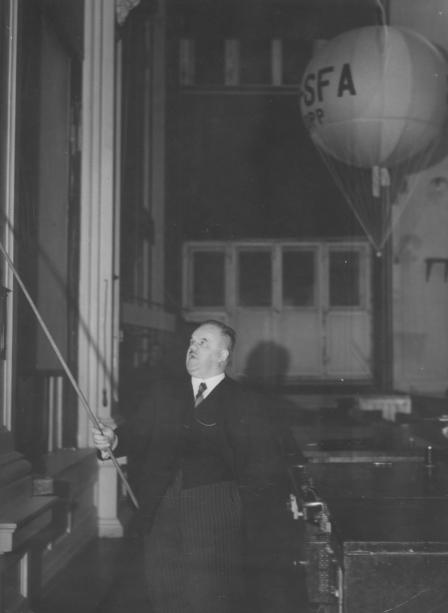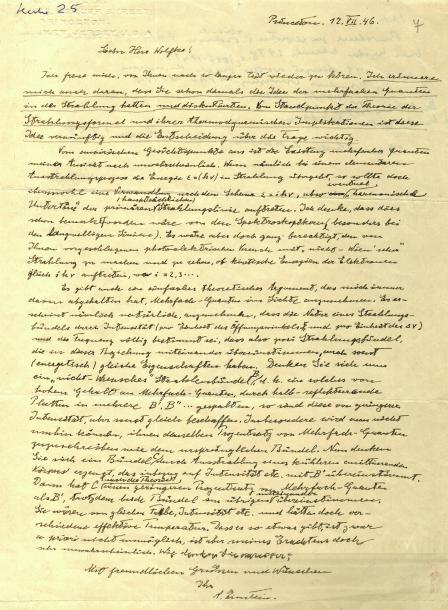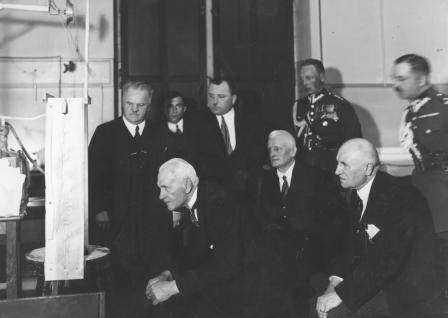The activity of Professor Mieczysław Wolfke
In 1921, the Department of Physics I was established at the Faculty of Electrical Engineering (later Electrical), and in 1922 Professor Mieczysław Wolfke became the head of this department, who, as Professor Sz. Szczeniowski - was an outstanding physicist.
Professor Wolfke (Fig. 13) obtained his doctorate at the University of Wrocław, and habilitation at the Technical University in Zurich. His habilitation thesis referred to the theory of image formation in a microscope. In 1920, he published a paper in "Physikalische Zeitschrift", which contained the idea of exposing an intermediate diffraction image to light from a different source in a microscope and thus obtaining a proper image. This idea, which was ignored, became the basis for the development of holography in much later years - after the discovery of the laser.
At the end of 1924, Professor Wolfke pointed out that helium can be solidified under high pressure. He then realized this idea in Leiden together with professor W.H. Keesom in 1926, using a pressure of the order of 100 atmospheres at a temperature below 4 Kelvin. A year later, in collaboration with Professor Keesom, the existence of two types of liquid helium was discovered, the second type, helium II, occurring below 2.19 K, turned out to be - as it was found in 1938 - a quantum liquid, devoid of viscosity, i.e. over-liquid. As is known, in the 1930s, theoretical and experimental studies of superfluidity were one of the leading issues in the physics of low temperatures. Just before the war, Professor Wolfke organized the Institute of Low Temperatures at the Polytechnic University, but he did not manage to develop it.
Profeosr Wolfke was not only an eminent theorist, but also an excellent experimenter and promoter of physics. Already in his youth, as a 17-year-old student, he patented a "wireless telectroscope" (Fig. 14), which was to be used to transmit images over a distance using electromagnetic waves. It was just a prototype of a television set. The invention - exhibited in Lviv at the jubilee exhibition of the Polytechnic Society - although it gained wide publicity, was not disseminated, but it testifies to the innovative talent and scientific temperament of the young Mieczysław Wolfke. In the Russian (!) Monthly "Radio" (p. 43, 1983) it was written that the inventor of television was a Pole - Mieczysław Wolfke.
Professor Wolfke's activity during the twenty years when he was (as a full professor) head of the Department of Physics at the Warsaw University of Technology (in 1920 he was appointed to the Department of Theoretical Physics at the University of Warsaw, but he soon resigned from this job) is extremely rich. He dealt not only with low-temperature phenomena, but also optics, where he gained a serious position on an international scale. He was open to problems related to the application of physics in technology and national defense. Professor Wolfke's lecture delivered at the 6th Congress of Polish Physicists on September 1, 1932, entitled "Physics and Technique" has not lost its relevance even today. These interests of professor Wolfke are very well expressed in the opinion given in the memoirs by prof. W. Łaniecki ("Quarterly of the History of Science and Technology", Rok XXIII, p. 552):
In conversations with me, Professor Wolfke often said that research on practical issues is sometimes much more difficult than purely scientific work. It is now known that he led research commissioned and financed by military authorities in his lean facility. For example, a method of improving photoelectric cells sensitized to various spectral ranges, in particular to infrared, was searched. For this purpose, research on crystalline phosphors was carried out by Dr. W. Leeg, a researcher at the Warsaw University of Technology. In 1938, Professor Wolfke developed a project of an anti-aircraft missile that would automatically self-aim at an enemy plane. This design takes into account that the engine exhaust gas is a source of intense infrared radiation. According to Professor Wolfke's project, these rays were supposed to act on a photoelectric cell, coupled with a radio-technical system, acting on the rocket rudder. This project was taken seriously by the competent military authority.
He was strongly interested in nuclear physics, hence his works on neutrinos, cosmic rays, and the atomic bomb. He wrote about it in the same way in the booklet "Atomic bomb" (fig. 15):
Already in May 1939, on the basis of the material provided in scientific journals, I was able to predict the possibility of using atomic energy for war purposes and calculate the destructive power of its action. On this subject, I published an article in "Polska Zbrojna" entitled "Atom explosion", in which I drew the attention of our society to the dangerous possibilities of the atomic bomb. Together with our great ballistics specialist, Col. Felsztyn, we calculated that a 1 kg uranium bomb is absolutely destructive within a radius of 20 km ... "The most powerful explosive of the future"; in May of that year, I spoke publicly about the need to control German science because of this terrible weapon. In June this year. I referred to this topic in the article in "Nowa Epoka" entitled: "Danger of Science". So when the press made the sensational news in the first days of August about the first nuclear bomb launched on Japan, it was no surprise to me, and I was only surprised that it was so late.
In 1938, Jan Blaton, Szczepan Szczeniowski, Mieczysław Wolfke and Stanisław Ziemecki made an attempt to launch a balloon with physical equipment in order to conduct studies of the stratosphere and cosmic rays. The balloon filled with hydrogen caught fire during take-off in the Chochołowska Valley. Most of the shell was saved, helium was purchased, and the next take-off near Stryj was planned in September 1939, but the outbreak of the war prevented this undertaking.
This extremely dynamic scientific, organizational and scientific work of Professor Wolfke could be a model for others. This is what Professor H. Jakubowski from the Faculty of Electrical Engineering writes about him in his memoir article:
Prof. Mieczysław Wolfke (1883-1947), PhD at the University of Wrocław, assistant professor at the Polytechnic School in Zurich, in 1925 he could boast a list of 42 scientific publications in various fields of physics, including works related to the properties of dielectrics at the temperature of liquid helium. In the field of cryogenics, he played a pioneering role in Poland. His students knew him best from the book "Principles of the Theory of Heat" (1924). Prof. M. Wolfke transferred the traditions of foreign universities to Poland, initiating doctoral and postdoctoral studies. This action had a catalytic effect on the entire Faculty.
The lectures by professor Mieczysław Wolfke made a great impression on the students, so much so that they remembered their content and atmosphere even after many years (Fig. 16).
This is what one of them recalls:
...The lectures were held in the magnificent building of Physics. The great amphitheater Auditorium for several hundred listeners made quite an impression. At the bottom, next to the enormous size of the lecturer's desk, there was a table, at least several meters long, on which various exhibits, devices and the so-called sets for conducting experiments were placed. During the lectures, the professor was accompanied in white coats by assistants and lab technicians who, at the lecturer's instructions, illustrated his scientific arguments in a practical way. The lecture gave the impression of some mysterious ritual, during which the magician-sage, surrounded by priests, was celebrating a great mystery.
Although Professor Wolfke often presented very complex problems of theoretical physics, his lectures were very popular not only among students but also among the wider audience. The physics exam, as one of the most difficult ones, always caused high levels of stress in students. To defuse it, the students told each other all sorts of jokes. For example, it was said that:
Wolfke himself sets the fountain in motion, which beats in the courtyard of the Warsaw University of Technology, and if the stream gushes high, which means that he is in a good mood, you can pass it. If it is low - it is better not to show yourself to him because he is furious.
Professor Wolfke was a personality well-known in the European physical environment and in a highly established position. That is why he was visited in Warsaw by physicists of the kind that professor A. Piccard, professor J.D. Cockroft, professor L. De Broglie, prof. W.H. Keesom.
He also knew A. Einstein and corresponded with him (Fig. 17).
The Chair of Physics of prof. Wolfke was visited by the highest representatives of the Polish State, such as President I. Mościcki, ministers and generals of the Polish Army, with whom he worked closely. (fig. 18.)


